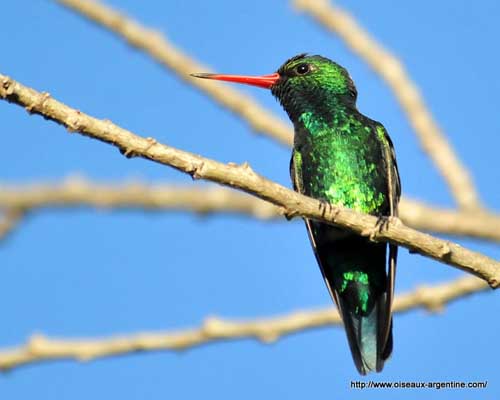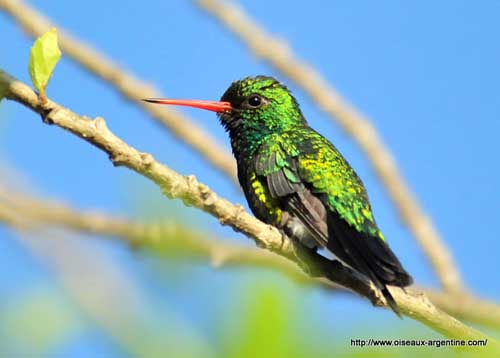
Fr: Emeraude splendide
All : Goldbauch-Smaragdkolibri
Esp: Esmeralda Ventridorada
Ital: Colibrì smeraldo ventredorato
Nd: Goudbuik-smaragdkolibrie
Sd: Glanssmaragd
Port: Besourinho-de-bico-vemelho
Photographers :
Eduardo Andrés Jordan
MIS AVES – AVES DE ARGENTINA
Philippe and Aline Wolfer
OISEAUX D'ARGENTINE
Text by Nicole Bouglouan
Sources :
HANDBOOK OF THE BIRDS OF THE WORLD Vol 5 by Josep del Hoyo-Andrew Elliott-Jordi Sargatal - Lynx Edicions - ISBN: 8487334253
BirdLife International (BirdLife International)
Glittering-bellied Emerald
Chlorostilbon lucidus
Apodiforme Order – Trochilidae Family
BIOMETRICS:
Length: M: 9-10 cm – F: 7,5-8,5 cm
Weight: 3,5-4,5 g
DESCRIPTION:
The Glittering-bellied Emerald was formerly known under the scientific name of Chlorostilbon aureoventris.
The adult male has gold-green upperparts with emerald-green uppertail-coverts.
On the underparts, the belly is iridescent bronze-green, whereas chin, throat and upperbreast are blue-green. Usually, underparts are more iridescent than upperparts.
Flight and tail feathers are bluish-black. The tail is slightly forked.
On the head, the male has dull bronze-green crown and forehead, with small whitish post-ocular patch and blackish lores.
The short, straight bill is red with black tip. The eyes are dark brown. Legs and feet are blackish.

The female has slightly golden-green upperparts, including crown and forehead. Uppertail-coverts are emerald-green.
Underparts are whitish with pale brownish-grey breast and belly. The tail is slightly forked. Rectrices have green bases and broad blue tips. The four outer tail feathers are blue with pale grey V-shaped tips.
On the head, the bill has more extended black tip than in male. There is a whitish post-ocular streak behind the dark eye.
The juvenile resembles adult female.
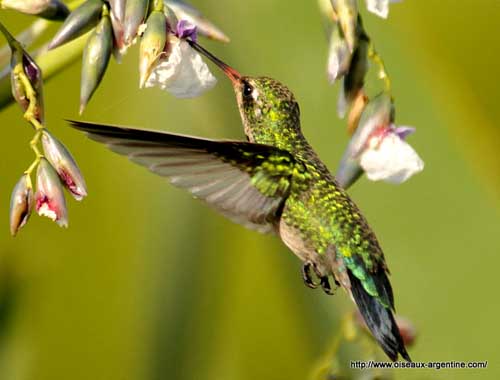
We can find four subspecies:
C.l. lucidus (here described) is found in Bolivia, Paraguay and WC Brazil.
C.l. pucherani occurs in E Brazil. This race is slightly smaller than nominate.
C.l. igneus is found in NW Argentina. This one has belly sprinkled with glittering orange-gold.
C.l. berlepschi occurs in S Brazil and Uruguay to NE Argentina. This race has purer green (not gold-green) plumage than nominate.
VOICE: SOUNDS BY XENO-CANTO
The Glittering-bellied Emerald gives high-pitched chirps and whistles. Calls are very short and often given from exposed perches such as shrubs and treetops. These calls are uttered by territorial birds feeding at rich food sources.
Alarm calls are shrill and given at high frequency when the birds are threatened.
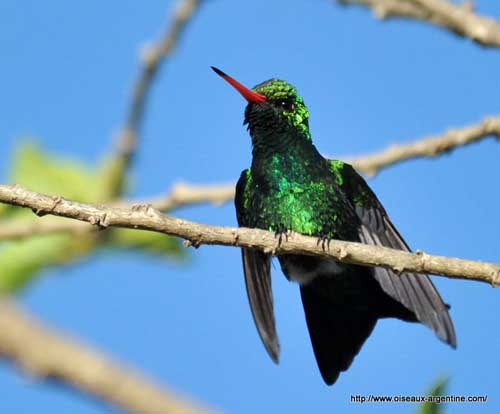
HABITAT:
The Glittering-bellied Emerald is common in a wide range of semi-arid to moderately humid scrub, savanna, grassland, edges of subtropical moist forests and also parks and gardens.
This species is visible from sea-level up to 3500 metres of elevation according to the range. But it is commoner between 500 and 2500 metres.
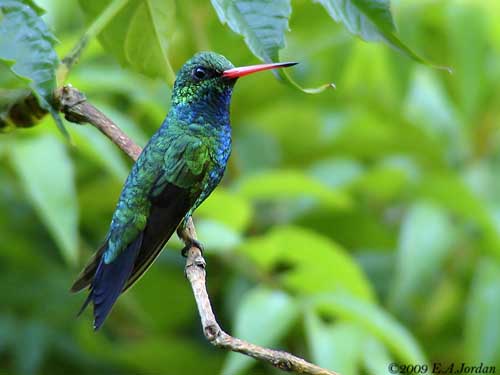
RANGE:
See above in “subspecies”
BEHAVIOUR:
The Glittering-bellied Emerald feeds primarily on nectar from several flowers. It gets the nectar by piercing the petal bases. That explains the short, straight bill, different from Trochilidae taking nectar inside the corolla and having longer bills.
It feeds by trap-lining, following a repeated foraging circuit (trap-line). But it also takes insects caught in the air by hawking, and spiders.
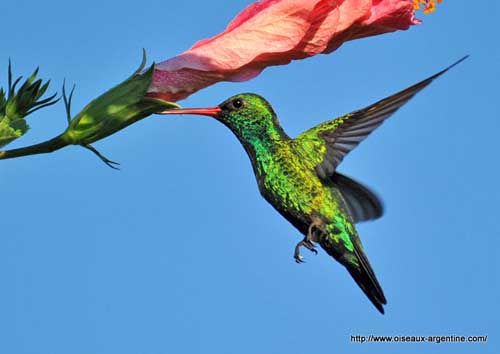
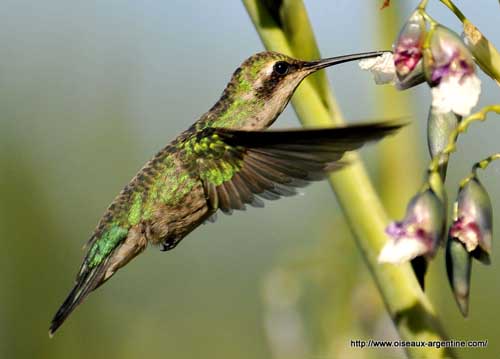
The feeding sites are defended against intruders although these foraging circuits or trap-lines are often too scattered to be defended. But other intermediate defence behaviour can be performed according to the feeding area and its food sources, such as chasing of other hummingbirds or large insects by aerial and intimidating displays.
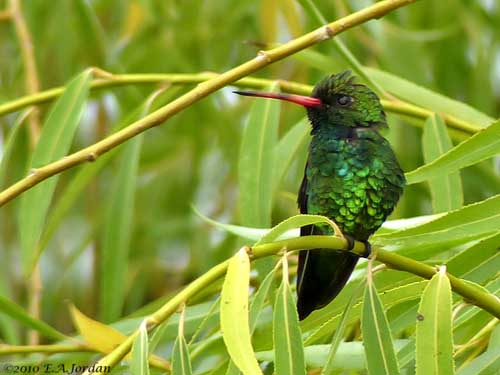
Some courtship displays by the male are reported at the beginning of the breeding season. It performs aerial displays in front of the female, a U-shaped flight. The male separates from the female after mating, and may mate with several females. It does not take part in nesting duties and the female chooses the nest-site, builds the nest and rears the chicks. However, she also may mate with other males.
They do not show flocking behaviour, and social contacts only occur at abundant food sources or at roosting sites. These nightime roosts are usually protected by vegetation.
This species is resident in its range.
FLIGHT:
The Glittering-bellied Emerald, like all Trochilidae, performs flycatching in front of flowers when feeding on nectar. They are able to fly in all directions with rapid 8-shaped wingbeats.
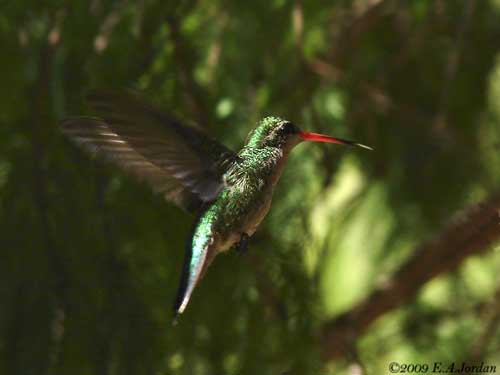
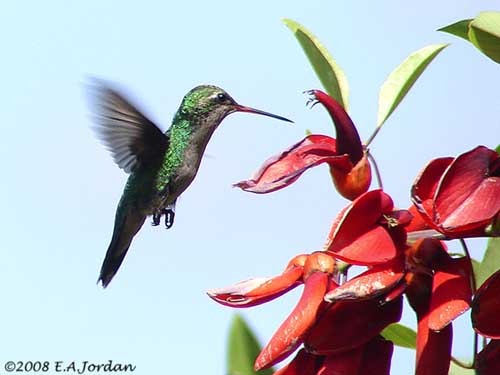
REPRODUCTION:
The breeding season occurs between August and November.
The female builds a cup-shaped nest in small tree, on thin branch or even on exposed root at about one metre above the ground. The cup is made with plant fibres, pieces of leaf and bark strips. All these materials are held together with woven spider webs. Green moss and lichens are added to the outer part as perfect camouflage in the vegetation. The inner cup is lined with softer materials such as downy seeds or plant fibres.
The female lays two white eggs and incubates alone during two weeks. At hatching, the chicks have dark grey down with two dark rows on the back. The female feeds them by regurgitation of partially digested insects. The chicks leave the nest about 7-10 days after hatching, and fledge at 20-22 days. They can breed in the second year.
The female alone protects the chicks, performing threat behaviour by flight attack against intruders or predators approaching the nest-site.
DIET:
The Glittering-bellied Emerald feeds on nectar from numerous flowers such as Tabebuia, Eucalyptus and Jacaranda acutifolia. It pierces the base of petals to get the nectar. It also feeds on fruits of Ficus diabolicus. Insects are caught by hawking in the air, and it also takes spiders.
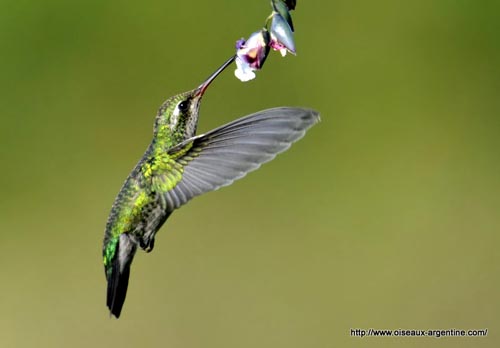
PROTECTION / THREATS / STATUS:
The Glittering-bellied Emerald is common throughout the wide range. It can be found in man-made areas such as parks, gardens and plantations, and it occurs in several protected areas.
This species is not currently threatened.
